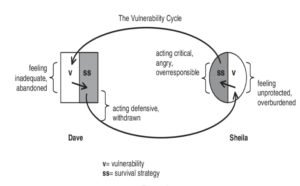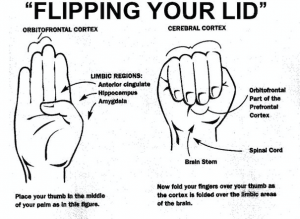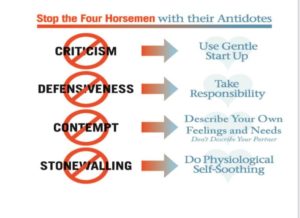Communication Problem
Dr John Gottman can listen to a couple for 5 minutes and determine, with 91% accuracy, whether they’ll divorce. How can he tell who will split up? There are a number of indicators but at the core of Gottman’s research are ” The Four Horsemen.” The four things that indicate a marriage is in trouble are Criticism, Contempt, Defensiveness and Stonewalling.
A video clip on “Four Horsemen of the Apocalypse” by Dr John Gottman
Learn to use the Antidote to stop the Four Horsemen is key to a loving and intimate relationship. Working on your negative communication patterns early in the relationship, or as soon as you begin to sense trouble, may save you a substantial amount of heartache down the road.
According to Terry Real, the 3 steps to get more of what you want in your relationship from your partner are:
-
- Dare to rock the boat
- Teach Them What You Want
- Make It Worth Their Time
Vulnerability Cycle
We all have vulnerabilities and learnt to protect our emotional vulnerabilities by using our survival strategies since young. The common strategies used are defensiveness, blaming or withdrawing.
Our survival strategies do help us feel less vulnerable, but they inhibit our empathy towards our partner and loved ones. They do not help to promote effective communication and healthy conflict in relationship. They only help to protect our vulnerabilities on the expense of our closeness and intimacy with our partner and loved ones.
When a vulnerability is “triggered” in conflict, it starts a cycle. That vulnerability triggers a survival strategy, then that survival strategy will often trigger the other partner’s vulnerability, which triggers his or her survival strategy. It is circular, meaning it does not matter who initiates the sequence, it becomes an endless loop.
When we are caught in an argument, it would be unwise to either avoid the conflict or counter attack; it would be wiser to find a better way to engage in the conflict by showing our vulnerabilities than using our survival strategies so that we would not be caught in a negative cycle that both feel defeated and hurt.
Understanding Our Brain Under Stress
Dr. Daniel Siegel’s hand model of the brain allows us to understand why it’s difficult to control our reactions when we’re overwhelmed with strong emotions, especially when we are triggered, overwhelmed or under stress.
The brainstem regulates the basic functions of our body, like breathing and heart rate.
The limbic system is responsible for our emotions, memories, and activating instinctive survival reactions. The amygdala is responsible for detecting danger and sends a signal to our autonomic nervous system to react accordingly.
At the same time, cortisol, a stress hormone, will be released. It will get our heart racing and our breathing to accelerate. High levels of energy will be sent to our muscles so that we can get away from the threat as soon as possible. This is the fight or flight response.
The prefrontal cortex is our thinking brain. It helps us evaluate the situation detected by the amygdala and control our emotional response before our feelings escalate to the point, we can’t control them.
 A closed fist shows an emotionally regulated brain that’s responsible for making rational and wise decisions. The amygdala, prefrontal cortex, and brain stem are all connected. The outer part of your folded fist is the cortex where all the planning and thinking happens.
A closed fist shows an emotionally regulated brain that’s responsible for making rational and wise decisions. The amygdala, prefrontal cortex, and brain stem are all connected. The outer part of your folded fist is the cortex where all the planning and thinking happens.
When our fingers are raised, the prefrontal cortex and amygdala disconnect. It is what we refer to as “Flip our Lids”. It happens when we get angry or stressed about something. The prefrontal cortex (thinking brain) shuts down, and it no longer works with the rest of the brain.
At this stage, we can’t use our problem-solving skills, logic or reason. This is where the tantrums and meltdowns kick in, and it’s super hard to make any thoughtful decision when we are angry. The brain needs to take a breather to be able to reconnect.
Understand Our Enneagram Communication Styles
The Enneagram can help us understand our own communication style and use it more effectively to understand ourselves and others. Our Enneagram Type influences communication on both the speaker’s and listener’s ends:
- The Enneagram Type of the speaker shapes what they focus on, how they communicate the message (tone and language) and what else might be implied at the same time (meta-message).
- The Enneagram Type of the listener influences their perceptual filters and, therefore, the received message – it shapes what the person will notice, colours their interpretation of meta-messages, influences what they might be triggered by, and even the extent to which they are likely to clarify.
This article “Communication Styles of the Nine Types” shows different patterns of what people will or will not focus on, how they communicate, and their meta-messages.
The video below provides a good summary of how each Enneagram Type communicates.
Understand Our Enneagram Conflict Styles
Each Enneagram Type reacts to conflict in a different way. The conflict styles of each Enneagram Type are divided into three different groupings as each group has a common way of handling conflict. The three groups are: Positive Outlook, Competency and Reactive. Each group shows how each Enneagram Type copes with and attempts to handle conflict as well as obstacles and disappointment.
Understanding our conflict style not only help us to have a better relationship with others, but also help us determine our enneagram type if you are still not sure about your Enneagram Type.
This article “Conflict Styles of Each Enneagram Type” provides an overview of how each type handles conflict.
The “Relationship Tips for the Nine Types” by Peter O’Hanrahan provides good tips on how to handle conflict with each Enneagram Type.
The video below provide a good summary of how to relate to each Enneagram Type in conflict.
Prevent Conflict Escalation – Time-Out
When we get triggered or overwhelmed during arguments, our thinking brain is offline, our survival brain takes over, we can no longer use our thinking brain to guide us. We will use our survival strategies to protect ourselves, eg. defensiveness, blaming or withdrawing. When conflict escalated further to attacking each other, it can reach a point of verbal or physical abuse.
The best way to prevent conflict from escalating out of control is to take an effective time-out.
A well-timed break must happen before partners start to feel overwhelmed. When either of you are emotionally flooded, the loving part of your brain shuts off and the fighting part takes over.
Kyle Benson’s “6 Steps to an effective Time-out That Stop Nasty Conflict” provides a step-by-step guide to implement an effective time-out.
Mindful Communication – Imago Dialogue
The Imago Dialogue is a powerful communication tool developed by Dr. Harville Hendrix and Dr. Helen Hunt. This simple communication tool creates a structure for partners to talk about their issues feeling safe, better heard and understood. With mutual understanding and empathy, partners feel safe and connected and be able to handle their differences and solve their problems more effectively.
The 3 main steps of the Imago Dialogue are:
• Mirroring
• Validation
• Empathy
Through guided in-session practice, you would become aware of the destructive interactional patterns in your relationship, and learn to break these negative patterns and begin to form new ways of communicating that is based on honesty, respect and true intimacy.


